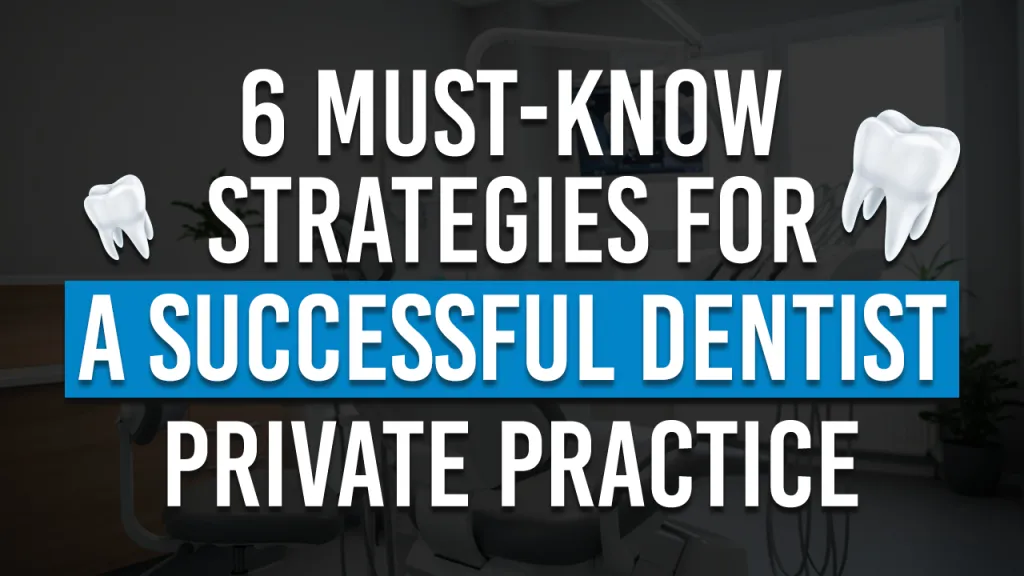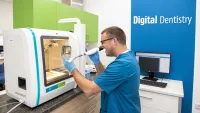
Author: Dr. Brian Tanz, DDS | Dental Practice Transitions Specialist
Owning and operating a successful dentist private practice requires more than just clinical excellence. It demands a strategic, multi-faceted approach that integrates patient care, business acumen, and forward-thinking growth initiatives. While the path to a thriving practice is unique for every owner, certain foundational strategies consistently yield remarkable results, boosting profitability, patient loyalty, and long-term value.
This guide explores six pivotal strategies that can transform your practice from a daily operation into a valuable, growing asset. Whether you are looking to enhance current operations, prepare to buy a practice, or position your business to sell, these insights provide a clear roadmap. Understanding these key areas is crucial not only for growth but also for accurately determining your practice's true worth with a professional valuation. We will delve into actionable steps for patient experience, marketing, service expansion, technology, team development, and financial management to help you unlock your practice's full potential.
1. Patient Experience Excellence Strategy
A Patient Experience Excellence Strategy is a comprehensive approach focused on delivering exceptional, positive encounters at every patient touchpoint. It transforms a standard dental visit into a comfortable, seamless, and memorable experience, moving beyond clinical proficiency to encompass the entire patient journey. This strategy is foundational for a successful dentist private practice, as it directly impacts patient retention, referrals, and overall practice reputation. It begins the moment a potential patient discovers your practice online and continues through scheduling, the in-office visit, billing, and post-treatment follow-up.

This approach differentiates your practice in a competitive market by building deep-rooted patient loyalty. For example, some forward-thinking practices implement spa-like amenities such as heated neck pillows, aromatherapy, and noise-canceling headphones to reduce dental anxiety. Others utilize patient concierge services to handle scheduling, insurance queries, and appointment reminders, creating a frictionless process.
Implementation
To effectively implement this strategy, focus on both the physical environment and your team's interpersonal skills.
Elevate In-Office Comfort: Invest in comfortable, modern waiting room furniture and consider adding a beverage station. For the operatory, offer amenities like blankets and sunglasses to enhance comfort during procedures.
Empathetic Communication Training: Train all staff, from the front desk to clinical assistants, in active listening and empathetic communication. This ensures patients feel heard, understood, and cared for.
Streamline Digital Touchpoints: Implement user-friendly online scheduling, digital intake forms, and automated appointment reminders via text or email to respect your patients' time.
A superior patient experience is no longer a luxury; it is a core business driver. It fosters positive online feedback, which is crucial for growth. To further enhance your patient experience and attract new patients, consider the role of patient reviews as a marketing secret for medical practices.
2. Digital Marketing and Online Presence Optimization
A Digital Marketing and Online Presence Optimization strategy is a multi-channel approach designed to attract new patients and build your practice's reputation online. In an era where most patients begin their search for a new dentist online, this strategy is essential for the growth and visibility of any dentist private practice. It encompasses search engine optimization (SEO), social media engagement, online review management, and targeted digital advertising to ensure your practice appears prominently when potential patients are looking for dental services.

This comprehensive approach moves your practice from being a passive entity to an active participant in the digital marketplace. For instance, a well-executed local SEO campaign can help a practice rank at the top of Google for valuable search terms like "dentist near me," driving consistent, high-quality traffic. Similarly, targeted Google Ads campaigns have been shown to generate a significant number of new patients each month for practices that invest in them strategically, proving the direct impact of a strong online presence.
Implementation
To effectively implement this strategy, you must create a cohesive and professional brand image across all digital platforms.
Claim and Optimize Google My Business: Your Google My Business listing is your digital front door. Fully complete your profile, add high-quality photos of your office and team, and post regular updates to engage with local searchers.
Encourage and Manage Online Reviews: Actively ask satisfied patients to leave reviews on key platforms like Google and Healthgrades. Positive reviews are a powerful trust signal for prospective patients.
Use High-Impact Visuals: Showcase your work with high-quality before-and-after photos (always with patient consent) on your website and social media. This visual proof can be a compelling decision-making factor for new patients.
A strong digital presence is not just about being found; it's about converting online searchers into scheduled patients. Beyond general marketing, specific strategies like focusing on maximizing conversions through sales funnel optimization can significantly boost your patient acquisition.
3. Comprehensive Service Expansion Strategy
A Comprehensive Service Expansion Strategy is a calculated approach to growing a dentist private practice by broadening the scope of services offered. Instead of focusing solely on general and preventive dentistry, this strategy involves integrating specialized treatments like orthodontics, cosmetic procedures, or dental implants directly into the practice. This transforms the practice into a comprehensive, multi-disciplinary hub, enhancing its value proposition for patients seeking convenient, all-in-one dental care. By keeping more procedures in-house, you significantly increase revenue per patient and minimize patient attrition due to referrals.
This strategic expansion can have a dramatic financial impact. For instance, many general practices see substantial revenue growth by adding clear aligner therapy like Invisalign, while others generate hundreds of thousands in additional revenue by incorporating implant services. The infographic above illustrates a typical phased expansion, allowing a practice to master and market one specialty before introducing the next. This methodical growth builds clinical confidence and establishes a strong market presence as a premier one-stop dental solution.
Implementation
Successfully integrating new services requires a focused plan that balances clinical training, equipment investment, and targeted marketing.
Master One Specialty at a Time: Resist the urge to add multiple services at once. Begin with a high-demand service that aligns with your interests, like cosmetic dentistry, and invest in top-tier training from renowned institutions like the Kois Center or Spear Education to achieve clinical excellence.
Invest in Technology and Training: Finance necessary equipment, such as a CBCT scanner for implants, through dental-specific lenders who offer favorable terms. Ensure your entire team receives training to support the new service from a clinical and administrative standpoint.
Market to Your Existing Patient Base: Your current patients are your most valuable asset. Announce new services through email newsletters, in-office signage, and personal conversations to generate initial cases and build momentum before marketing to the broader community.
Expanding services is one of the most powerful levers for growth in a dentist private practice, directly boosting profitability and market appeal. If you're acquiring a practice with an eye toward growth, understanding its potential for service expansion is crucial. Explore the 7 comprehensive steps to buying a dental practice to learn more.
4. Technology Integration and Modernization
Technology Integration and Modernization is the strategic implementation of cutting-edge dental technology and digital systems to enhance clinical outcomes, boost operational efficiency, and elevate the patient experience. This approach involves incorporating tools like digital radiography, CAD/CAM systems, and advanced practice management software into the daily workflow of a dentist private practice. By modernizing, a practice can reduce costs, improve diagnostic accuracy, and sharply differentiate itself from competitors relying on outdated methods.

This strategy fundamentally transforms patient care and practice operations. For instance, practices using CEREC systems can design, mill, and place a crown in a single visit, a powerful value proposition for busy patients. Similarly, a fully digital workflow for impressions can reduce chair time and material costs while improving accuracy. During the COVID-19 pandemic, practices with teledentistry capabilities were able to maintain continuity of care, demonstrating the resilience that technology provides.
Implementation
Successfully integrating new technology requires a clear plan focused on return on investment and patient benefits.
Prioritize Patient-Centric Tech: Focus first on technologies that directly improve the patient journey, such as intraoral scanners that eliminate messy impressions or digital X-rays that reduce radiation exposure.
Smart Financial Planning: Consider leasing major equipment initially to preserve cash flow and avoid a large capital outlay. This allows you to test the technology's impact before committing fully.
Comprehensive Team Training: Ensure your entire staff receives thorough training before a full rollout. A well-trained team is essential for maximizing the technology's benefits and ensuring a smooth transition.
Choose Integrated Systems: Select technologies that communicate with each other. An integrated ecosystem, from practice management software to imaging systems, streamlines workflows and prevents data silos.
Technology is no longer just a clinical tool; it is a critical business asset that directly influences practice value. A modern, tech-forward practice is often appraised higher and is more attractive to potential buyers. To understand how modernization impacts your practice's worth, explore professional dental practice valuations.
5. Team Development and Staff Excellence Program
A Team Development and Staff Excellence Program is a human resources strategy focused on systematically recruiting, training, and retaining exceptional dental team members. This approach recognizes that skilled, motivated staff are the backbone of a successful dentist private practice, directly influencing patient satisfaction, operational efficiency, and profitability. It moves beyond simple hiring to create a workplace culture where every team member is invested in the practice’s growth and aligned with its core values.
This program is critical for building a high-performing team that delivers consistent, high-quality care and service. For instance, practices that implement robust development programs often achieve staff retention rates above 95%, which ensures continuity of care and a stable patient experience. Others use team-based incentive programs, such as production bonuses, which have been shown to increase overall practice production by as much as 20-30% by aligning staff and owner goals.
Implementation
To build a thriving team, you must invest in both their professional skills and their integration into your practice’s culture.
Hire for Attitude, Train for Skill: Prioritize candidates who demonstrate a positive attitude, strong work ethic, and a natural fit with your practice culture. Clinical and administrative skills can be taught, but a great attitude is invaluable.
Invest in Continuous Growth: Provide regular continuing education opportunities, such as funding attendance at dental conferences or bringing in experts like those from the Pride Institute for in-office training. This keeps your team’s skills sharp and shows you are invested in their careers.
Align Goals with Incentives: Implement a transparent profit-sharing or production-based bonus system. When the team shares in the practice's financial success, they become more motivated to improve efficiency and enhance patient care.
Your team is your practice's most valuable asset. A cohesive, well-trained, and motivated staff reduces operational friction and is the engine for sustainable growth. Properly valuing your team is as important as understanding your practice's financial valuation, especially when considering a future sale. You can learn more about how a strong team impacts your business's worth on our dental practice valuations page.
6. Financial Management and Revenue Optimization
Financial Management and Revenue Optimization is a strategic framework designed to enhance the fiscal health of a dentist private practice. It moves beyond basic accounting to encompass sophisticated strategies in case acceptance, insurance negotiation, treatment planning, and overall profitability analysis. This comprehensive approach ensures the practice not only delivers outstanding clinical care but also operates as a financially sound and sustainable business, allowing for continuous investment in technology, staff, and patient care.
This strategy is vital for maximizing revenue while upholding the highest ethical standards and maintaining patient trust. For instance, practices that refine their case presentation methods often see case acceptance rates jump to 75% or higher. Similarly, implementing third-party financing options like CareCredit can increase treatment acceptance by up to 40% by making necessary care more accessible. Optimizing insurance relationships and coding practices can also lead to a significant increase in reimbursements, often by 15% or more.
Implementation
To implement a robust financial strategy, focus on empowering both your patients and your team with clarity and confidence regarding treatment costs and value.
Focus on Patient Benefits: Train your team to present treatment options by emphasizing the long-term benefits to the patient’s health and well-being, rather than just listing clinical features.
Provide Flexible Payment Solutions: Offer multiple payment options, including phased treatment plans and third-party financing, to accommodate different patient budgets and reduce financial barriers to care.
Empower Your Team: Conduct regular training to ensure all staff members can discuss financial matters compassionately and confidently, turning potentially awkward conversations into positive, solution-oriented discussions.
Utilize Visual Aids: Employ intraoral photos, 3D models, and educational software to visually demonstrate the need for treatment, making the value proposition clear and compelling.
Proactive financial management is the engine that powers practice growth and stability. Mastering these systems is fundamental, whether you're looking to enhance your current operations or considering the next step in your career. Understanding the financial intricacies is also a critical part of financing the purchase of a dental practice.
6-Point Strategy Comparison Guide
Strategy |
Implementation Complexity |
Resource Requirements |
Expected Outcomes |
Ideal Use Cases |
Key Advantages |
|---|---|---|---|---|---|
Patient Experience Excellence Strategy |
High - requires time & training |
Significant upfront investment |
Increased patient retention & referrals |
Practices aiming for premium pricing & loyalty |
Higher treatment acceptance, reduced marketing costs |
Digital Marketing & Online Presence Optimization |
Medium - ongoing management |
Moderate, may need specialists |
Measurable ROI & steady patient acquisition |
Practices focused on attracting new patients online |
Cost-effective targeting, builds credibility |
Comprehensive Service Expansion Strategy |
High - capital & training intensive |
High investment in equipment & staff |
Revenue per patient increase by 300-500% |
Practices growing service lines & revenues |
Multiple revenue streams, enhanced reputation |
Technology Integration and Modernization |
High - phased roll-out with training |
Very high capital & ongoing costs |
Improved diagnostics and efficiency |
Practices differentiating via advanced tech |
Faster treatments, competitive advantage |
Team Development and Staff Excellence Program |
Medium - continuous training & culture building |
Moderate payroll & training |
Higher productivity and lower turnover |
Practices prioritizing staff retention & culture |
Improved patient care consistency, team loyalty |
Financial Management and Revenue Optimization |
Medium - process and training focused |
Moderate consultation & training |
Increased case acceptance and profit margins |
Practices optimizing revenue & financial health |
Better cash flow, higher profitability |
Building Your Practice's Future, One Strategy at a Time
Navigating the complexities of a dentist private practice requires more than just clinical skill; it demands strategic vision and operational excellence. Throughout this guide, we've explored six critical pillars that form the foundation of a thriving, modern practice. From cultivating an unparalleled patient experience and mastering digital marketing to strategically expanding services and integrating cutting-edge technology, each element works in concert. Investing in your team's development and rigorously managing your financials are not just best practices; they are the engines of sustainable growth and profitability.
The journey of owning a dentist private practice is a marathon, not a sprint. The consistent implementation of these strategies does more than improve your daily operations and bottom line. It systematically builds the long-term, tangible value of your most significant professional asset. A practice with a stellar reputation, efficient systems, a loyal patient base, and a motivated team becomes a highly sought-after entity.
The value of your dentist private practice isn't a static number. It's a dynamic reflection of the strategic decisions you make every day. By focusing on these core areas, you are actively preparing for a successful future, whether that involves continued growth or a profitable transition.
This enhanced value becomes paramount when you begin to consider your exit strategy. A well-documented, efficiently run practice with strong fundamentals and clear growth potential is not only easier to transition but also commands a significantly higher valuation in the marketplace.
As you move forward, consider which of these strategies can be implemented immediately.
Assess: Conduct a quick audit of your practice against the six strategies. Where are you strongest? Where are the biggest opportunities for improvement?
Prioritize: Select one or two key areas to focus on for the next quarter. Perhaps it's launching a new staff excellence program or investing in a specific piece of technology.
Execute: Create a simple, actionable plan with clear goals and timelines.
Ultimately, taking control of these strategic levers empowers you to build not just a successful business, but a lasting legacy.
